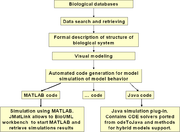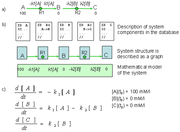Difference between revisions of "BioUML"
(→Reproducible research) |
|||
| Line 55: | Line 55: | ||
===Reproducible research=== | ===Reproducible research=== | ||
| − | Reproducible research is the common name for functionality for saving, representing and reproducing a set of data manipulation. BioUML provides special [[Projects]] collections, [[workflows]] and [[# | + | Reproducible research is the common name for functionality for saving, representing and reproducing a set of data manipulation. BioUML provides special [[Projects]] collections, [[workflows]] and [[Workflows#research diagram|research diagram]]s for this purpose. |
===Collaborative research=== | ===Collaborative research=== | ||
Revision as of 17:26, 26 April 2013
| This page or section is a stub. Please add more information here! |
BioUML is an open source integrated Java platform for analysis of data from omics sciences research and other advanced computational biology, for building the virtual cell and the virtual physiological human. It spans a comprehensive range of capabilities, including access to databases with experimental data, tools for formalized description of biological systems structure and functioning, as well as tools for their visualization, simulation, parameters fitting and analyses. Due to scripts (R, JavaScript) and workflow support it provides powerful possibilities for analyses of high-throughput data. The plug-in based architecture (Eclipse run time from IBM is used) allows to add new functionality using plug-ins.
The whole system aims at covering, with time, all areas of computational applications in bioinformatics and systems biology. The architecture is open, so that users' own scripts can be easily loaded into the system, and new modules can be programmed and added by any skilled person. The community is invited to contribute to the development, either as public-domain or as a commercial part of the platform. The developers are confident that this way a most powerful and needed system of tools can grow.
The team also hopes that BioUML will contribute to creation of virtual cell, virtual physiological human and virtual patient, which would be extremely useful in medicine as a means of computational identification of the most effective therapeutic interventions and for prediction of potential outcomes of intended treatments for a given patient.
Contents |
Principles
Visual modeling
Reconstruction of complex biological systems from a huge amount of experimental data requires a formal language that can be easily understood both by the human and the computer. It is known that graphical depiction of complex systems is the most suitable way of understanding their structure by humans. Graphical notation allows humans to completely and formally specify model so computer programs can analyze the model and simulate its behavior.
This approach is widely used in engineering and computer science. Some examples are:
- MATLAB/Simulink (http://www.mathworks.com)
- AnyLogic (http://www.xjtek.com) - muli-method simulation software
- UML (http://www.omg.org/uml/) - the most known graphical language for computer science.
BioUML adopts the visual modeling approach for formal description and simulation of complex biological systems.
Another distinctive feature of BioUML is a tight integration with databases on biological pathways, query engine allows user to find interacting components of the system and show results as an editable graph.
BioUML also fully exploits principles of modular modeling.
Meta-model
The core of BioUML is a meta-model. It provides an abstract layer (compartmentalized attributed graph) for comprehensive formal description of wide range of biological and other complex systems. The content of databases on biological pathways, SBML (Hucka M. et al., 2003) and CellML(Lloyd C.M. et al., 2004) models, as well as biological pathways in BioPAX format can be expressed in terms of the meta model and used by the BioUML workbench.
This formal description can be used both for visual depiction and editing of biological system structure and for automated code generation to simulate a model behavior. Meta-model is problem domain neutral and splits the system description into 3 interconnected levels:
- graph structure - the system structure is described as compartmentalized graph;
- database level - each graph element can contain reference to some database object;
- mathematical model - any graph element can be element of mathematical model.
BioUML supports the following mathematical elements: variable, formula, equation, event, state and transition.
The figure demonstrates how this approach is applied to modeling a system consisting of two consecutive chemical reactions. Here the graph nodes representing chemical substances are considered as variables and the corresponding graph edges contain right parts of corresponding differential equations. Using this information the BioUML workbench can generate MATLAB or Java code for model simulation.
Special BioUML diagrams markup language (DML) is developed to store BioUML meta model instance in XML format. Diagram description is divided into two parts:
- graph structure - it describes location of diagram elements and contains references to associated with them database objects;
- executable model - stores mathematical model associated with graph.
Detailed description of DML format is available at http://www.biouml.org/dml.shtml
Reproducible research
Reproducible research is the common name for functionality for saving, representing and reproducing a set of data manipulation. BioUML provides special Projects collections, workflows and research diagrams for this purpose.
Collaborative research
| This page or section is under construction right now. |
Architecture overview
BioUML platform consists of 3 parts:
- BioUML server - provides access to data and analyses methods installed on the server side for BioUML clients (workbench and web edition) via the Internet.
- BioUML workbench - Java application that can work standalone or as "thick" client for BioUML server.
- BioUML web edition - "thin" client for BioUML server (you just need to start web browser) that provides most of functionality of BioUML workbench. It uses AJAX and HTML5 <canvas> technology for visual modeling and interactive data editing.
Plug-in based architecture
The plug-in based architecture determines extensibility of the BioUML platform. This functionality is provided by Eclipse platform runtime kernel.
The basic components of the plug-in based architecture are:
- Plug-in, the smallest unit of BioUML workbench function that can be developed and delivered separately into the BioUML workbench. Plug-ins are coded in Java. A typical plug-in consists of Java code in a JAR library, some read-only files, and other resources such as images, message catalogs, native code libraries, etc. A plug-in is described in an XML manifest file, called plugin.xml. The parsed contents of plug-in manifest files are made available programmatically through a plug-in registry API provided by Eclipse runtime.
- Extension points, well-defined function points in the system where other plug-ins can contribute functionality.
- Extension, a specific contribution to an extension point. Plug-ins can define their own extension points, so that other plug-ins can integrate tightly with them.


